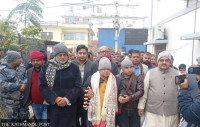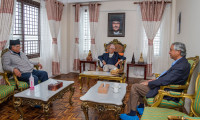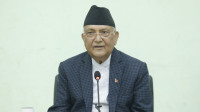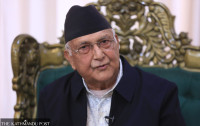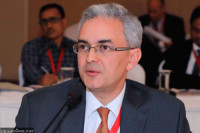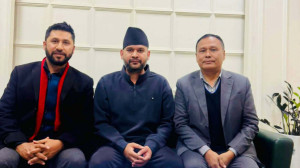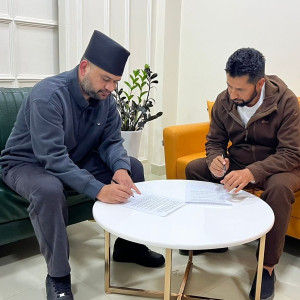Politics
There are more women in politics, but few and far between at decision-making level
Despite inclusion refrain, there is a huge underrepresentation of females in Nepali political parties and state organs..jpg&w=900&height=601)
Elisha Shrestha
Late last year, Prime Minister KP Sharma Oli reshuffled his Cabinet, removing six ministers and three state ministers while inducting new faces to replace them. The number of women ministers in the old Cabinet was already low. But after the reshuffle, the share of women was less than 10 percent, just two out of 22 ministers were women.
“The appointments, the reshuffle has not been on a merit basis. As much as I agree to merit in every aspect, the co-chairs’ cannot fool its citizens saying ‘we cannot find qualified women parliamentarians to be ministers’, sorry [SIC],” wrote one user on social media, pointing out the lopsided gender ratio.
What was worse, as many pointed out, was that Tham Maya Thapa was removed from the Ministry of Women, Children and Senior Citizens to make way for Parbat Gurung, a man.Only Bina Magar, who is minister for water supply; Padma Kumari Aryal, minister for land management and cooperatives; and Shiva Maya Tumbahangphe, minister for law and justice, are currently in the Oli Cabinet
To the rest of the world, Nepal may seem like a beacon for women’s political representation. The country has had more women in the legislature, thanks to a provision that sets aside 33 percent seats for women in all state mechanisms—from federal to local.
In 2015, Nepal elected Bidya Devi Bhandari as its first woman president. In 2016, three of Nepal’s top state positions—president, chief justice and Speaker of the House—were held by women.
But the presence of women at the top, even in a position as symbolic as that of the President, has not translated into similar successes for female leaders in other state organs.
Despite an increased participation of women in politics over the past two decades or so, their progress in leadership positions continues to be hindered, primarily by male leaders who are unwilling to make way— or even choose—qualified women. As a result, female politicians have often been sidelined by their male counterparts from leadership and decision-making roles, a pattern that reflects just how patriarchal Nepal still is.
In 2006, as soon as Parliament was restored following the second people’s movement, deputy speaker Chitralekha Yadav was not promoted to the post of Speaker. Instead, Subas Nembang was given the post. According to Binda Pandey, a lawmaker from the Nepal Communist Party (NCP), the Nepali Congress supported Nembang’s nomination even though he was from a rival party instead of Yadav, who was a Congress member.
Again, during the 2013 Constituent Assembly election, Suprabha Ghimire of the Nepali Congress was asked to give up her candidacy from Kathmandu Constituency-4 to make way for Gagan Thapa.
“The fact that Nepali society is still reluctant to accept women as leaders is clearly reflected in Nepal's political scenario,” said Asta Laxmi Shakya, a standing committee member of the ruling Nepal Communist Party.
Shakya herself was passed over for chief minister of Bagmati Province in favour of Dormani Poudel despite the fact that she was a senior politician.
Many women politicians believe that the parties have embraced women’s representation not because they are convinced that it is the right thing to do but because they are forced to do so by the constitutional provisions. Their rhetoric of equality and inclusion does not necessarily translate into actions, they say.
Local elections held in May, June and September in 2017 provide a good glimpse into how women were largely underrepresented. The elections were held to elect 35,041 local representatives across 753 local federal units including six metropolitan cities, 11 sub-metropolitan cities, 276 municipalities and 460 rural municipalities.
Women were mostly elected for deputy positions—91 percent of them— with just 2 percent of women getting mayoral or chair positions in 753 local units.
According to Manushi Yami Bhattarai, a central committee member of the Samajbadi Party Nepal, the majority of women are deemed fit only for secondary roles, such as for deputy positions, and that too, simply to satisfy the inclusion provision. “Thus, women’s representation is largely tokenistic,” said Bhattarai.
Even within political parties’ internal committees, women representation is low.
Article 15 (4) of the Political Parties Registration Act clearly states that women must represent at least one third of the membership in all party committees.
Even the ruling party—the Nepal Communist Party—has failed to abide by the legal inclusion provision, as it has only 75 women in its 441-member central committee. The party Secretariat, the highest decision-making body, does not have a single woman member while the 45-member Standing Committee has just two women. The Election Commission agreed to register the Nepal Communist Party only after an assurance that it will abide by the provision of 33 percent women representation through general convention. During its merger in May 2018, the party had said it would hold its convention within two years.
The underrepresentation of women is not only limited to the ruling party though.
According to Chanda Chaudhary, a lawmaker from the Rastriya Janata Party Nepal, there is 33 percent women’s representation in Parliament because of the legal provisions.
The Nepali Congress has only 18 women in its 85-member Central Committee, according to Pushpa Bhusal, a Nepali Congress leader.
The Rastriya Janata Party Nepal, formed after the merger of six parties, has only around 70 women in its over 800-member Central Committee, said Chaudhary.
“We will know the exact number of members in our Central Committee after the party’s general convention. But it does not look like the party will be able to meet the 33 percent women representation criteria,” said Chaudhry.
Bhattarai from the Samajbadi Party said in the 425-member Central Committee of her party, there are only 52 women.
Prakash Adhikari, a leader from the Samajbadi Party, said the reason for underrepresentation of women in politics is simply because of the lack of qualified women for the leadership positions.
“The party has always nominated candidates on merit basis. To be a member of the Central Committee, one has to have years of political experience and academic qualification, which a majority of women politicians lack,” said Adhikari.
But female politicians say when it comes to men, both the qualifications cited by Adhikari—experience and academic degrees—are simply ignored.
They also describe the argument regarding a lack of qualified female leaders as an excuse. The trend of viewing women in the form of tokenism will be changed once qualified and deserving women themselves speak up against the discrimination they face, they say.
This was felt early this year, when Shiva Maya Tumbahangphe became the only female person in Nepali politics to publicly lay claim to the post of Speaker.
Although Tumbahangphe was forced to resign as Deputy Speaker to make way for Agni Sapkota for the position of Speaker, she was firm on her argument that she was as qualified as her male counterparts to lead the House. After her resignation, she even went on to say that patriarchy was more entrenched in the Nepali society than monarchy.
Pandey from the Nepal Communist Party, who had thrown her weight behind Tumbahangphe, said that when qualified and deserving female politicians like Tumbahangphe voice her opinion to be treated as per the qualification, it is an answer to the people who say “women aren’t qualified enough for top positions”.
“The politicians in power often favour their kin and factions, while they ignore the deserving candidates,” said Pandey. “Even when it comes to their factions, they choose weak leaders, who don’t oppose them.”
While Pandey acknowledges that it may take time for female politicians to have equal status as their male counterparts, she says that women leaders also must keep raising their voices.
“Politicians like Tumbahangphe aren’t saying ‘I deserve this because I am a woman’. They are simply confident enough to demand to be treated equally since they know that they are capable and competent,” said Pandey. “When qualified women like Tumbahangphe start being vocal about their rights, parties will start to take women’s political participation seriously.”
Both Chaudhary and Bhattarai say that ensuring 33 percent women should not be limited to Parliament. This should be ensured in every state mechanism and it must be the main agenda, as the government has still failed to do so, they say.
“We are advocating 33 percent women’s representation in the Central Committee of my party,” said Chaudhary. “Hopefully, the party members will acknowledge gender inclusivity at the upcoming general convention.”




 5.47°C Kathmandu
5.47°C Kathmandu (1).jpg)
